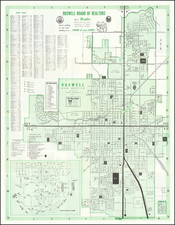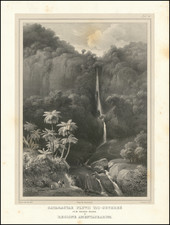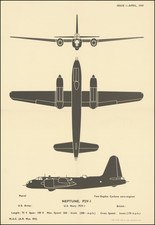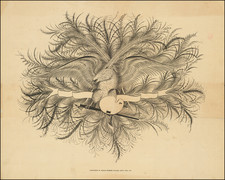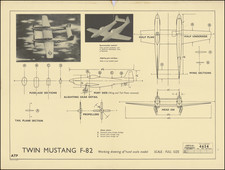First U.S. Jet Fighters
This poster, produced by the Ministry of Supply, is one in a collection of aircraft identification posters created by the U.K. post-WWII. The print showcases multiple images of two early jet aircraft, Lockheed's F-80 Shooting Star and North American Aviation's F-86 Sabre, to help identify these new planes in the sky.
On the left, the F-80 Shooting Star is displayed with four images of various flight angles to aid identification. The accompanying text lists the Lockheed Aircraft Corporation's achievement of producing the first U.S. jet-propelled aircraft and subsequent modifications made to improve the plane.
The right side of the poster is dedicated to the F-86 Sabre. It includes four dynamic images capturing the aircraft's versatility in flight, notably the top left which shows the plane going into a dive. The brief text describes how North American Aviation tested the F-86 and achieved the feat of being the first U.S. aircraft to break the sound barrier.
The F-80 and F-86
During the end of the Second World War, multiple nations were on the cusp of implementing jet technology into their air forces. Germany's powerful Messerschmitt 262 and Ardo 234 were threats to the Allies during the latter part of the conflict which spurred the development of jet aircraft in the U.S. and U.K.
The United States began testing the F-80 Shooting Star in 1944 with the Army Air Corps approving the aircraft soon after. Due to the late stage of the conflict, however, the F-80 never saw service in World War II. Rather, the plane was used to train and develop pilots' aptitudes for jet fighters which increasingly appeared to be the new standard for military aircraft.
The F-80 got its chance to prove itself with the outbreak of the Korean War. Early in the war, the F-80 was used extensively, becoming among the first aircraft to engage in a jet plane dogfight. While the F-80 was an incredible achievement for its time, the craft was quickly becoming outclassed by new jet technology found in planes like the F-86. The F-80 was still a viable plane, just not for combat and the U.S. Air Force continued to use the plane to train aviators. While the F-80 Shooting Star may not be the most iconic aircraft, it was a first in U.S. aviation and helped pave the way for future jets.
As jet technology improved so too did the understanding of aerodynamics and flight. The F-86 Sabre illustrates this development quite well, being the first U.S. jet fighter to use swept-back wings and tail-units. These modifications made the craft more aerodynamic while also increasing its maneuverability, setting a standard for future jet designs. The F-86 first saw service in the Korean War, famously facing off against the newly designed Soviet MiGs. The Air Force was pleased with the plane's performance and claimed a favorable kill ratio in the air throughout the conflict. Like the F-80, the F-86 Sabre represents a major leap for U.S. aviation and jet technology.









